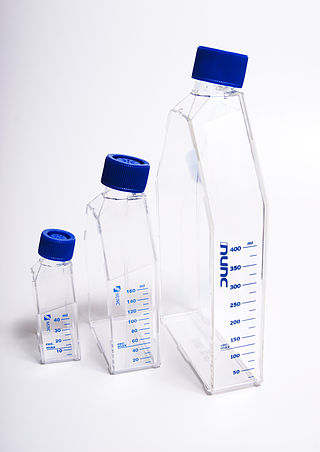Top Qs
Timeline
Chat
Perspective
Roux culture bottle
Type of laboratory glassware From Wikipedia, the free encyclopedia
Remove ads
Remove ads
A Roux culture bottle, or simply Roux bottle, is a type of laboratory glassware used in biology and related sciences to grow microorganisms or tissue cells.[1]: 5 [2]: 1886 It consists of a bottle of transparent glass[3] or plastic[4] with two closely spaced flat, rectangular, parallel faces and a short neck; of such a design that the bottle can be laid down sideways, on one of those two faces, even when unstoppered and partially filled with a culture medium. This goal is achieved by having the neck narrowed,[3] offset,[5] partially blocked,[6][7] or canted (tilted).[8][9] The item is also generically called cell culture bottle[4] or tissue culture (TC) bottle,[8] and flask may be used instead of "bottle".[3]


A Roux bottle provides a large surface for the cells or microorganisms to grow, whether on the top of,[10] floating in,[11] or at the bottom of the medium.[12] The flat upper face then allows inspection of the culture and even illumination for photosynthetic organisms.[11] Organisms growing at the bottom of the medium can also be inspected from below, with an inverted microscope.[13]
The bottle is typically closed with a plug or cap that prevents contamination of the culture by spores from the outside, while still allowing exchange of gases generated or consumed by the organisms inside.[12]
The bottle's invention has been attributed to French physician and Pasteur's collaborator Pierre Roux (1853-1933).[14][15]
Remove ads
Variations
The "DeLong" type has a horizontal neck with a low barrier at the base.[7] There is a cylindrical version that is meant to be slowly tuned on rollers to keep the contents well mixed.[16]
See also
References
Wikiwand - on
Seamless Wikipedia browsing. On steroids.
Remove ads
